How GM, Chrysler, and AMC Reacted to the Original Ford Mustang
April 17 marks sixty years since the Ford Mustang’s public debut at the 1964 New York World’s Fair. The original pony car immediately became a pop-culture and automotive phenom, and it remains one of the most impactful cars in history. We’re celebrating with stories of the events surrounding the Mustang’s launch, the history of the early cars, and tales from owners. Click here to follow along with our multi-week 60 Years of Mustang coverage. -Ed.
Car people over a certain age certainly remember the April 1964 debut of Ford’s first Mustang. Enthusiasts yawned at first due to the car’s lowly Falcon-based platform and powertrains, but most were eventually charmed by its sporty looks, multiple appealing options, and affordable pricing.
U.S. auto executives outside the Blue Oval wondered whether to take it seriously. Bob Lutz (who would later rise to top leadership levels at Ford, Chrysler, and General Motors) had been working at GM Overseas Operations (GMOO) for a bit more than a year when Mustang was launched. “The clan of car guys l hung out with agreed it was a genius marketing move,” he tells Hagerty. “We didn’t admire it as a car because of its down-and-nasty Falcon architecture, but we agreed it would be a hit. We underestimated how big of a hit, but so did everyone else. Its appeal was NOT to car guys but to average, low-to-middle-income Americans who saw it as glamorous and aspirational.”
Reaction from GM leadership was initially dismissive. According to Lutz, they calculated the entire U.S. auto sales market at the time at 100,000 units. “Let’s say it’s a smash hit and gets 50 percent of that segment. ‘That’s 50,000 units. Why bother?’ They failed to realize that Ford did not intend [the Mustang to be] part of the ‘sports car’ segment but as cheap, sporty, aspirational family transportation. Once they fully grasped what Ford had pulled off, it was all-hands-on-deck, full speed ahead.”
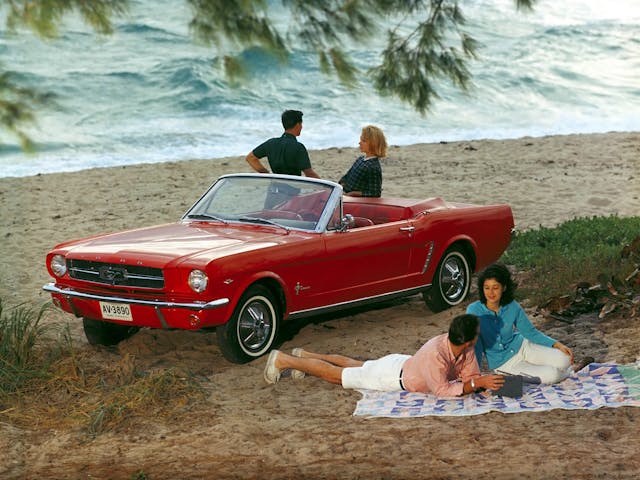
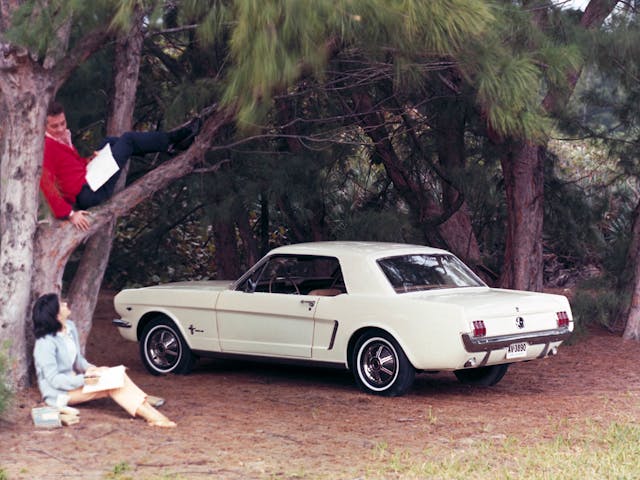
GM and its Chevrolet Division didn’t see that initial ’65 Mustang as a serious threat, but few outside (or even inside) the company knew that Chevy designers had been quietly exploring the same idea of a youthful, sporty compact coupe since soon after the Chevy II debuted for 1962. The project was inspired by the elegant 1963 Buick Riviera “personal coupe” that was launched to take on Ford’s four-seat Thunderbird. Chevrolet styling chief Irv Rybicki wondered whether something similar to the Chevy II in concept but smaller and much more affordable—which could share the Chevy II’s unibody platform and mechanicals—might make sense for Chevrolet. When Rybicki suggested exploring such a car to GM Design Vice President William L. “Bill” Mitchell, Mitchell was intrigued. “By God, that’s not a bad idea!” he reportedly said, “But let’s do it outside the building where no one in the corporation can see what we’re up to.”
“So, we went across the street to our warehouse, created a little room there and started a program,” Rybicki later told us. “And in five months, they had a Chevy II-based clay model dimensionally very close to the future Mustang that no one outside of Ford knew was being developed. But when Rybicki showed it to then-Chevrolet general manager S. E. “Bunkie” Knudsen, Knudsen liked it but decided not to pursue it: “I’ll tell you, fellows,” he said, “one thing we don’t need right now is another car.”

Aside from its popular full-size line, Chevy’s stable at the time included the rear-engine Corvair, the compact Chevy II, the mid-size Malibu, and the Corvette sports car. Rybicki’s proposed sporty compact coupe would add a sixth separate car, and Knudsen didn’t see the need to invest the substantial money, time, and human resources it would take to make that happen.
Rybicki didn’t give up on the idea. Like Ford’s Iacocca, he could see America’s emerging youth market coming. In late 1963, Rybicki had Henry “Hank” Haga’s Chevrolet #2 Studio design a sleek Chevy II-based sporty coupe concept car called “Super Nova.” Mitchell liked it so much that he had it developed into a fiberglass-bodied running car and dispatched it to the April 4, 1964 New York Auto Show, where its appearance two weeks before the Mustang’s April 17 debut at the New York World’s Fair made some Ford folks nervous.
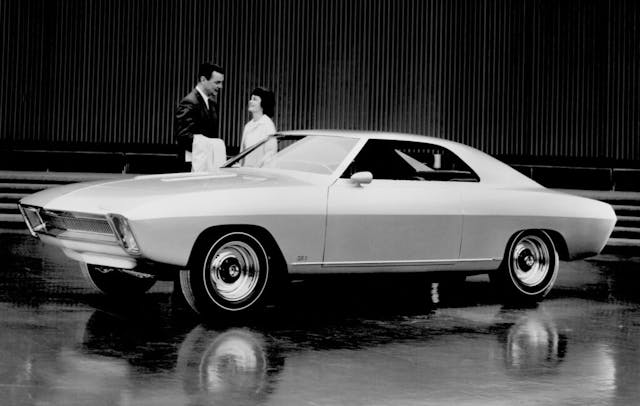
“I recall some of the Ford people coming over while I was standing there and asking whether we were going to build that car,” Knudsen said. “I remarked, ‘If they’ll let us, we’ll build it.’” But when he tried selling it to GM leadership, then-GM president Jack Gordon turned him down.
Camaro/Firebird


When the Mustang bowed to thundering media and public applause, then-Pontiac general manager Elliot M. “Pete” Estes was one GM leader who took it seriously: “I happened to be at Styling when the first Mustang rolled into the garage,” he later recalled. “Everybody was standing around saying what a disaster it was and how market research showed there was no market for it. I didn’t say anything but had a feeling that this thing was going to backfire on us.”
Jerry Palmer, who joined GM Design in 1966 and rose to executive director over all cars and trucks before his 2002 retirement, recalls seeing that first Mustang in its Ford Design studio while still in school at Detroit’s Society of Arts and Crafts (now the College of Creative Studies). “Homer LaGasse, who was on the Mustang design team, arranged a trip for our seniors to go through the studio,” Palmer relates. “The concept was a hot little car, but we were a little disappointed by the actual car.”

Retired GM designer Dick Ruzzin, who had been there for about a year and a half when Mustang was launched, says, on the contrary, that everyone there was surprised. “The design to me was very good as it had some of the character of the recent Lincoln, the sheer slab side and peaked fenders,” he recalls today. “I thought it was a great-looking car, but it was not seen as a performance car in any way. The muscle car era was just beginning, and Mustang responded to that and was part of that movement as it evolved through the years.”

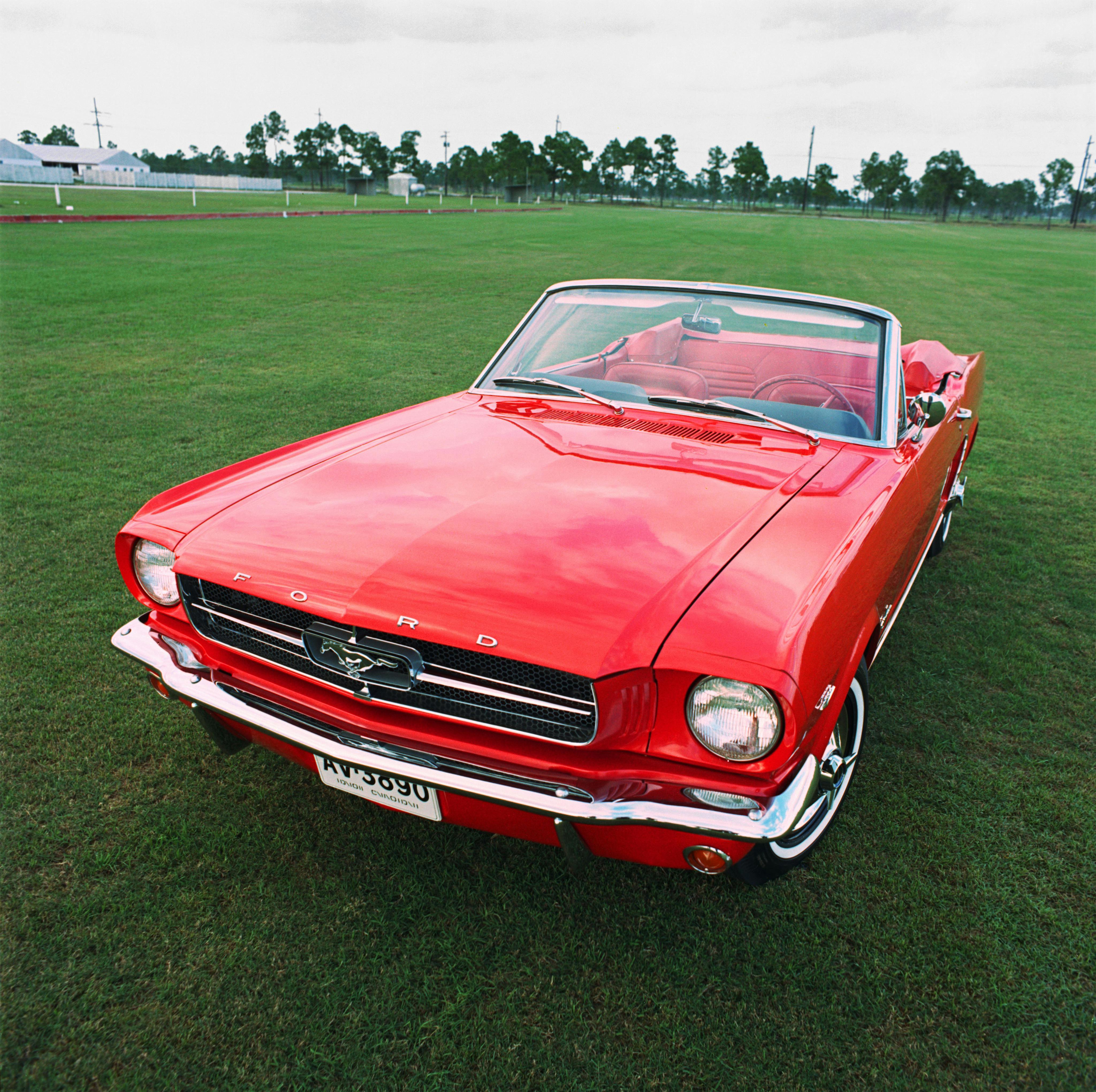
Because the rear-engine compact Corvair was getting a Corvette-look redesign for 1965, GM brass believed that its new style, its bucket-seat Monza coupe and convertible models, and its optional turbocharged engine would help it compete quite well with Ford’s new sporty car. Even Mitchell was telling everyone that the ’65 Corvair was Chevy’s answer to the Mustang.
After Mustang sales topped 100,000 in its first four months alone, with no sign of slowing on its way to the biggest first-year sales success of any new car in history, GM leaders found instant enlightenment. They suddenly decided to hurry up and counter Mustang with the small, sporty coupe and convertible that would become the 1967 Camaro and—partly to appease John DeLorean, who had succeeded Estes as Pontiac general manager and was lobbying hard for a two-seat sports car—a Pontiac variant to be known as the Firebird.
Barracuda/Challenger
Chrysler Corporation actually beat Mustang to market by a couple of weeks with its first Plymouth Barracuda. Believing rumors that Ford was developing a new sporty compact based on its inexpensive Falcon chassis and running gear, Chrysler execs saw an important new market segment and wanted an entry. “Chrysler predicted the ‘specialty compact’ segment would grow to 1.5 million sales by 1970,” Motor Trend reported, “of which it could easily claim 200,000 or more.” With a limited budget, stylist Irv Ritchie sketched the fastback coupe that debuted as a Barracuda option package on the compact Valiant on April 1, 1964.
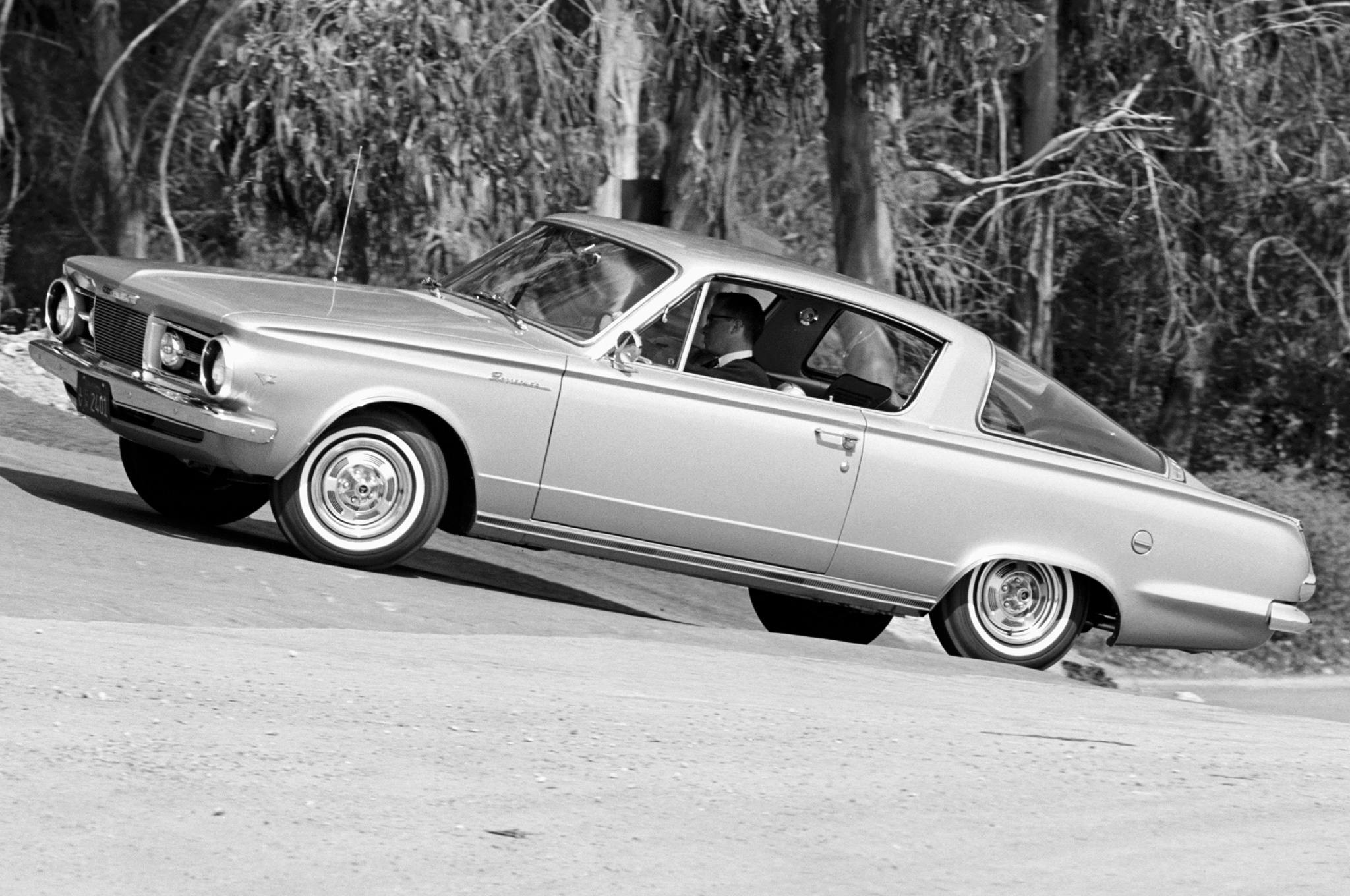

“The 1964 Plymouth Barracuda was essentially a fastback version of the Plymouth Valiant,” wrote Chandler Stark for musclecarclub.com in 2015, “and it was actually marketed as the Plymouth Valiant Barracuda initially. It used the same wheelbase dimensions and Chrysler A-body platform but with a massive wraparound rear window and taillight … At this stage, the Barracuda was more of a budget car …built for convenience and reliability, not performance.”
That hurry-up car was badly outsold by the Mustang, and it took three years to design and develop the much more competitive second-generation Barracuda for ‘67, which (like the Mustang) offered coupe, convertible, and fastback body styles. Three more years later, Chrysler’s Dodge brand jumped in with its slightly larger, more upscale ‘70 Challenger on an all-new shared platform.

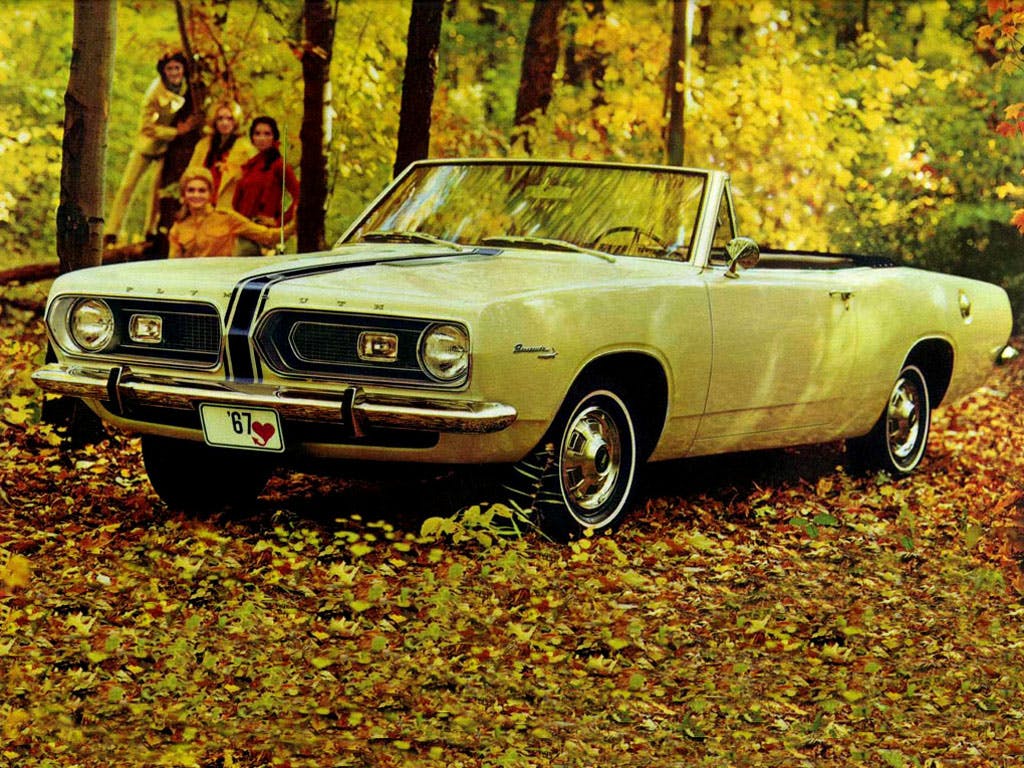

Retired Chrysler Design (and Engineering) vice-president Tom Gale explains that the Mustang arrived a few years before his time there began. “But I was very aware of its impact. For me, the lesson was getting the proportions right, which the Mustang did with its long hood and short deck. The 64-1/2 Mustang, albeit derived from the Falcon, really nailed the proportion with great style and gutsy leadership from Hal Sperlich and Lee Iacocca. Contrast that with the Plymouth Barracuda of the time, where it took until 1967 to make the improved design, which was still based on the A-body Valiant/Dart. But it wasn’t until 1970 with the E-body Barracuda/Challenger that competitors’ cars hit their stride and, in many ways, went beyond Mustang.”
One other Chrysler effort was the original 1966-67 Dodge Charger: a bucket-seat, fastback variant of the mid-size Coronet. Positioned as an upscale “personal luxury” coupe, its targets were much more the Thunderbird, Toronado, and Riviera than the Mustang, and it suffered the same slow-sales fate as AMC’s similar Rambler Marlin.
AMC and the Javelin

Over at the much smaller American Motors, design chief Dick Teague was challenged to design a viable Mustang competitor. A few months before Mustang’s debut, AMC had shown a concept fastback coupe, based on the compact Rambler American, called the Tarpon. Teague wanted to build that car as an answer to Mustang, but then-CEO Roy Abernethy ordered him to upsize that design on the mid-size Rambler Classic platform; that effort became the unlovely Rambler Marlin “personal luxury” coupe. But by mid-1965, Abernethy agreed that the Marlin was a loser, so Tarpon designer Bob Nixon (by then head of small-car exterior design) started work on a replacement initially known as the Rogue, a name AMC was using for its Rambler American hardtop coupe.
Even as the Rogue was taking shape, Chuck Mashigan’s advanced styling studio in October 1965 developed a design study for a Rambler American-based sporty fastback two-seat coupe that Teague named “AMX,” for American Motors Experimental. Teague proposed publicly exhibiting the AMX (which inspired the 1968 two-seat production AMX) and other advanced styling studies to demonstrate that AMC—under new Board chairman Robert Evans—was moving in a new, more youthful direction.
That idea evolved into an impressive “Project IV” traveling show that toured 10 North American cities in 1966, showcasing four concept cars that included the AMX and a longer “AMX II” 2+2 coupe designed by freelance stylist Vince Gardner.
Meanwhile, the production “pony car” project, with styling strongly influenced by the AMX and AMX II, was already under development and would debut (under new Board chairman Roy D. Chapin) as the AMC Javelin for 1968.
The landscape was truly abuzz when the first Mustang hit, an indicator that conditions were ripe for just this type of car. While GM could have fielded a sport-compact Chevy almost immediately after Mustang’s debut but chose to wait and see, Ford had the youthful new market segment practically all to itself (except for that first Valiant Barracuda) from spring ’64 to autumn ’66. By then, GM offered up its ’67 Camaro and Firebird, Chrysler fielded its ’67 Gen 2 Barracuda, and corporate cousin Mercury launched its Mustang-based upscale Cougar. It took another year for AMC to launch its nicely designed ’68 Javelin, and by the time the greatly improved Gen II Camaro, Firebird, Barracuda, and Dodge Challenger arrived for 1970, America’s youthful “pony” and “muscle” car segments were already starting to fade due to safety, emissions, fuel economy, and other government-imposed mandates. It was fun while it lasted.
***
Check out the Hagerty Media homepage so you don’t miss a single story, or better yet, bookmark it. To get our best stories delivered right to your inbox, subscribe to our newsletters.



I hardly think that “for 1970, America’s youthful “pony” and “muscle” car segments were already starting to fade due to safety, emissions, fuel economy, and other government-imposed mandates”
Those conditions came one-to-two years later.
MANY 1970 and 1971 “pony cars” were very fine performers.
An impressionable young man at the time, I was just never taken with the Mustang when released. It seemed to me that the late-to-the-game folks mostly came out with better looks. I loved the ’67 Camaro and Firebird, and although I’d dissed the first Barracuda, the Gen II in ’67 was a hit with me. When those AMX gonzocars hit in ’68, I was in love all over again (the Javelins made me cool back down, though). It wasn’t until the late ’60s and early ’70s that I began to warm up a bit to Mustangs – albeit only slightly warm. The whole Shelby and Hertz phases helped some, as I was deeply into performance. But by that time, I’d moved into Muscle Cars and except for a glance now and then at the Pony Cars that had edged into muscle territory, I pretty much ignored the Falcon/Chevy II/Valiant/Etc. derivatives.
Over time, FoMoCo sold as many Mustangs as there were stars in the sky (with a few of them re-engineered into Cougars) – but nary a one to me. Similarly, I’ve never owned a Camaro, Firebird, Barracuda, or any of the AMC Ponies. However, if that “Super Nova” as pictured been built, with its obvious nod to Riviera styling, I think I would have been hanging out down at the local Chevy dealership, looking to strike a deal.
Living in Europe and being young in the Midsixties, I was aware of the Mustang. But it was the Camaro that hit me as a Beauty. I liked the Mopar and AMC products as well. To this day I think the first Mustangs are incredibly overrated. Look at the European counter parts: I drove Ford Capri and Opel Manta A. Just compare the look of both: GM and Mopar cars were nearly always much prettier than Fords. And Chevies were better as well.
The Mustang Fastbacks that followed were actually much better looking than the very first ones.
As my Dad used to work for GM I am obviously not very neutral in my opinion.
I felt the same way having hit college age in the mid ’70’s and then being able to afford some of these pony cars second hand. I always thought the Camaro/Firebirds had a much more sleek & refined look.
A friend had a ’68 Firebird however, and it’s seat position seemed very low like a Corvette, which was unlike the ’68 Mustang I owned in which seating was a bit higher and upright. It may have just been an impression I had at the time but did make a difference in my own personal comfort level. I read somewhere that British cars of the time period had seat positioning more upright as well vs. other euro cars. Never heard any comparisons though between U.S. cars except for some mentioning of seat-jacking for Autocross competition in a book I once read.
The story here really highlights why the Pony car died. All three were based on a cheap RWD platform that could take a V8. That car died in the 80’s That was when the dedicated platforms came and these were no longer cheap cars or high volume like they were.
As for the Camaro and Firebird. This story highlights much the same GM confusion where the divisions and staff did not work as one against the other car companies as they worked harder fighting each other.
GM had the Corvair and Ed Cole was the strong leader of it. This help delay things. Ed lost his fight between the bad press and the real killer was the flat six was much more expensive to build then a more powerful 327.
Then Delorean wanted a two seat car. We saw this in the Banshee and a couple other concepts including a short wheel based camaro made into a Firebird roadster. Chevy even made a mock up. At the 11th hour Delorean was ordered to take the Firebird as is and finish it. This is why the Bird was late.
Many people miss that other than the quarter vents the 67-68 Bird is the same sheet metal with a new bumper. To make the changes Delorean wen to the suspension and did multi leaf springs and they added the traction bars. Pontiac got two on a 4 speed 400. Pontiac also lowered the car an inch and different size tires at the start. The cars were physically the same but mechanically Pontiac did a number of changes.
If GM had worked closer and better on this car it may have come sooner. But even at that the performance parts that came for the Camaro more than made up for the time. Vince Piggins really promoted the car for build ups and with Penske and Donohue in Trans Am and Grumpy in Super Stock along with the Cover car at Hot Rod testing new engines and parts they build a loyal enthusiast following that remains till today.
Ford also had some issues too. The Mustang early on was seen as secretary car. Lee wanted to beef it up so he worked with Shelby. Caroll expressed his true feeling to the car.
“In 1964, when Lee Iacocca said, ‘Shelby, I want you to make a sports car out of the Mustang,’ the first thing I said was, ‘Lee, you can’t make a racehorse out of a mule. I don’t want to do it. ‘ He said, ‘I didn’t ask you to make it; you work for me.
Well the rest is history. Ford did dodge a grave mistake in making the trunk of the car the gas tank. Yes remove the tank no trunk just a big hole. Many of these tanks would rupture in rear end collisions and they avoided the Pinto controversy,., They do offer safer tanks today to the hobbies. Ford did that in a number of cars till the Maverick. They also survived the Mustang II. Back in the say that was never accepted as they expected. The Fox body recued them. We mad a ton of money on Fox body Mustang parts in the 80’s.
The Chrysler was not a great car to start with and today the early cars are difficult to restore do to the lack of parts. The later cars made up for it but their time was limited. They really were decent cars and todays prices recent that.
AMC suffered the same thing as they always did. They were a mixed bag of parts. The Javelin really was a good car and the AMX even better. As time went on they became bloated and AMC was running tight on money. To be honest the AMX was due to the lack of money but I think it made it a better car being more basic and light.
The real question here is where would Ford have been if they let Bunkie and Larry continue with the path they were on. Their legacy of Mustang is still the high point of the cars life. The Boss and other variations they did in a short time really made up for what the car lacked. Then they get let go and then the car got big heavy and then the Mustang Two. Not great decisions. The 69 and 70 will never be topped. Even todays car still copies them. It is a shame Lee just could not get along with the two ex GM guys. Imagine if Delorean had come with them as to what they could have done.
For all the positives and negatives this is a great era of cars we will never see again. The Chevy and Dodge are gone and the Mustang is on borrowed time. The market changed and the key of the cheap RWD platform has put the end to the true Pony car. Only The Mustang remains as a true GT coupe even at the price it is you get a lot but that is still a big price.
‘The Chrysler was not a great car to start with and today the early cars are difficult to restore do to the lack of parts.’
Nonsense.
Classic Industries has tons of repro parts for those cars and for early A Bodies.
Hmm – I’ve owned a gen 1 Camaro and a body Barracuda. Hands down parts availability is better for the GM. Barracuda was a “cross your fingers” to see if you could find it. If you don’t believe me just try and find a metal repo front fender for a 67-69 Barracuda….
Sad to see that the Mustang is all alone now. This segment had lots of fun cars that are now memories.
Have you seen the 2025 Dodge Charger 2 door?
And the Hornet. Don’t count Chrysler out just yet.
Hornet Made in Italy, Fixitagaintony. No thanks
I didn’t see the Hornet on a recent list of cars available in the US with a manual trans. But then, the Corvette wasn’t on that list, either.
Oh ya, in white the Hornet looks just like an egg. Very sporty…
Bigger car, different class, wouldn’t you say?
By the time Knudson became the head of Ford the 69 Mustang design had already been set in stone. He was known for being responsible for the bigger and heavier 71 Mustang (aka ‘the aircraft carrier’ ) NOT the 69-70. He also told Fords designers ” Make these things look like Buicks” so they quickly tacked on the ‘Knudson Nose’ as it was then called. Shinoda (sp?) said, paraphrasing here- “By the time I got to Ford the Mustangs styling was already finished. All I could do was clean it up a bit. I got rid of the side scoops and and the emblem on the C pillar for instance. ” The running joke at Ford knowing that their days were numbered was as Henry Ford said ” History is bunk” – “Bunkie is history “.
The nose was actually referred to as the Bunkie beak
Here was the whole Bunkie Lee fight.
https://content.time.com/time/subscriber/article/0,33009,901485,00.html
https://www.indieauto.org/2021/06/22/david-halberstam-why-bunkie-knudsen-never-had-a-chance-at-ford/
Bunkie did not say make them look like Buicks. He did say to make the 70 T Bird nose look like a Pontiac. Actually not a bad move. The previous car was fine but was over do for an update. It was decent and at least did not look like a Lincoln.
The real problem was the system at Ford. In time the same thing ate Lee. HF2 had issues in a number of areas. Still the best Ford that got car design was Edsel. Also Edsel 2 hot performance. Bill really never got it and wisely stepped aside. Being family owned can be a blessing or a curse.
Not much innovation in the Camaro body design. When it first appeared, we all thought it was a Corvair… . the overall size, look & body styles were similar & if you don’t believe me, pull up the pics for the Corvair for the late 60’s and you’ll easily see for yourself.
Agree. Take a ’65 Corvair and move the tub a foot backwards, add a foot longer nose, shorten the deck and you got a ’67 Camaro. And to compete in power, GM could have easily added two more cylinders to make the Corvair 6 a flat 8 with 250 bhp. Porsche did it a couple of years later and very nearly won LeMans outright.
The neighbors across the street from my boyhood home in Detroit had a pair of Corvairs, His, a coupe. Hers, a convertible. In 1967, they replaced them with Camaros, His, a coupe. Hers, a convertible.
“Ford had the youthful new market segment practically all to itself (except for that first Valiant Barracuda)”
No, Ford had the segment entirely to itself. That first Valiant variation was not at all in the Mustang segment. Nobody cross-shopped that car.
Of all the competitive cars, the Camaro best understood what the Mustang had. The Gen1 Camaro understood the lines and proportions needed and kept the design looking light and svelte. The porky proportions that came later, catering to the muscle car crowd is what ultimately killed sales of the “pony” cars. Just look at the sales numbers of the Mustang II. Though derided heavily by enthusiasts, sales of the Mustang had been declining steadily since the 1970 model. Yet the Mustang II instantly tripled sales. More than once in Mustang’s history, it re-learned how to be the right car at the right time. That’s a big reason why it managed to survive for so long.
YOU 4/GOT about the 66 Chevelle 396 & GTO w/3 duces !!!!!
Uh, are those pony cars??? Hello?
I never cared for the first gen Camaro.
While the styling is okay, in the flesh they looked cheap…like pressed tin, very unsubstantial. You could see where they cut costs.
Externally, the Mustang did a better job at hiding the Falcon underpinnings.
Is it just me.
John – interesting points; I bought a Marina Blue ’67 from my sister a few years ago, just a base blue flame 6 model that she had outfitted with a 350 small block. The car is actually much more substantial than I expected it to be. That said, I do like first gen Mustangs also !!
Funny how everyone went with performance and muscle to go up against what was essentially a sporty looking commuter car that was built to be affordable and good looking enough to sell but not really be a muscle and performance car. The other companies were essentially selling the performance that the Mustang looked like it had but actually didn’t.
Regardless, Thank God for the Mustang, and good ole capitalist competition. WE were able to get our hands on some of the best cars overall, the “Pony Cars” love em.
I remain a huge fan of the 70’s Dodge Challengers, last to the party but my favorite of the pony cars. I bought a ’73 318ci used in ’76, my first true love. Dark metallic brown, white vinyl top, white interior with black carpets and dash, fun to drive, lovely to look at. Between 7 years in the Michigan salt then 10 years in the Houston humidity it finally just disintegrated around me, but what a wonderful ride.
I lived in Detroit and Houston. It was the salt up in Michigan that did it in.
Agreed. Nothing like a 70 Challenger with one of the performance engines, i.e. 340, 440 & Hemi. Back these up with a 4speed and you have the makings of too much fun. Mine was a ordered 340, 4 speed limited slip rear, am radio and rear defogger. GoManGo and burnt orange upholstery. Due to the truckers strike in early 1970 I waited 4 months for delivery. After I had the valve springs and the clutch return spring replaced I had 90,000 trouble free miles of fun.
Gotta love mom holding onto the baby while heading down the street!
I’m pretty sure my dad bought a 1963-1/2 Barracuda in Kentucky. It was the bronze color and I don’t recall the engine size but knowing my dad back then, it was probably the smaller engine (if there was a choice then). What I find strange though, in many pictures of these for sale now, none seem to show the same dashboard I distinctly remember: a pushbutton auto transmission on the left side of the dash with a sliding parking brake bar. I was a “paperboy” in 1970 and on Sunday mornings when the paper was big and full of adds, my sister would drive me around….and after out of sight from parents, she’d let me drive…at ten years old.